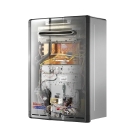Legionella management with continuous-flow hot-water systems

Many of the problems associated with controlling legionella bacteria in domestic-hot-water systems can be solved by choosing to install a gas-fired continuous-flow system, explains Chris Goggin, associate director with Rinnai UK.
With such a system, cold water enters the water heater directly from the mains and is immediately heated to advisory temperature levels.
Unlike stored water, there is no requirement to heat a volume of water to ensure the elimination of legionella bacteria, as the minimum temperature that a continuous-flow unit achieves is in excess of advisory levels. Legionella bacteria multiply where temperature are between 20 and 45°C.
However, Chris Goggin warns that there is a risk in secondary-return systems of water cooling to temperatures that risk the proliferation of legionella. He says, ‘For example, in a large leisure centre of usual size and public usage with no storage tanks, the pipework could hold up to 10 000 litres of static water when not in use.’
His solution is to run the system with a core temperature of 42°C during the day and deliver a thermal shock at 60°C intermittently at times when the building is not in use. By the time the building opens again, the core temperature is back down to 42°C for safe use.







